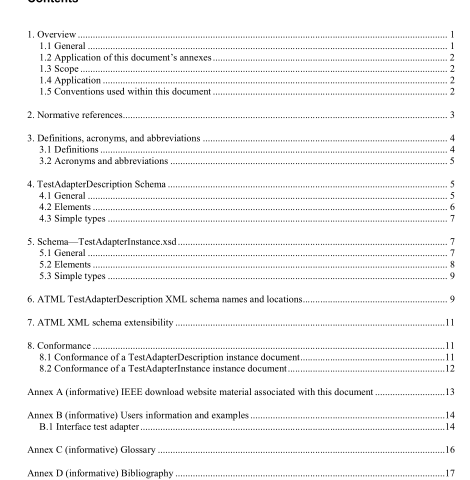IEEE 1671.5-2015 pdf download.IEEE Standard for Automatic Test Markup Language (ATML) Test Adapter Descriptio
The information contained in XML documents conforming to this standard will be useful to:
a) Test program set (TPS) developers
b) TPS maintainers
c) ATE system developers
d) ATE system maintainers
e) Developers of ATML-based tools and systems
f) UUT developers and maintainers
1.5 Conventions used within this document
1.5.1 General
In accordance with the IEEE Standards Style Manual [B3], 3 any schema examples will be shown in Courier font. In cases where instance document examples are necessary to depict the use of a schema type or element, such examples will also be shown in Courier font. When the characters “…” appear in an example, it indicates that the example component is incomplete.
All simple types, complex types, attribute groups, and elements will be listed; explanatory information will be provided, along with examples, if additional clarification is needed. The explanatory information will include information on the intended use of the elements and/or attributes where the name of the entity does not clearly indicate its intended use.
For elements derived from another source type (e.g., an abstract type), only attributes that extend the source type will be listed; details regarding the base type will be listed along with the base type. When referring to an attribute of an XML element, the convention of [element]@[attribute] will be used. In cases where an attribute name is referred to with no associated element, the attribute name will be enclosed in single quotes. Element and type names will always be set in italics when appearing in text. This standard uses the vocabulary and definitions of relevant IEEE standards.
In case of conflict of definitions, except for those portions quoted from standards, the following precedence shall be observed: 1) Clause 3, and 2) The IEEE Standards Dictionary Online [B2].
1.5.2 Precedence The TestAdapterDescription schema (TestAdapterDescription.xsd) element, child element, and annotation information shall take precedence over the descriptive information contained in Clause 4. The TestAdapterDescription schema and the material contained in Clause 4 shall take precedence over the example information represented in Annex B. The TestAdapterInstance schema (TestAdapterInstance.xsd) element, child element, and annotation information shall take precedence over the descriptive information contained in Clause 5. The TestAdapterInstance schema and the material contained in Clause 5 shall take precedence over the example information represented in Annex B.
1.5.3 Word usage In accordance with the IEEE Standards Style Manual [B3], the word shall is used to indicate mandatory requirements strictly to be followed in order to conform to the standard and from which no deviation is permitted (shall equals is required to). The use of the word must is used only to describe unavoidable situations.
The use of the word will is only used in statements of fact. The word should is used to indicate that among several possibilities one is recommended as particularly suitable, without mentioning or excluding others (should equals is recommended that). The word may is used to indicate a course of action permissible within the limits of the standard (may equals is permitted to). The word can is used for statements of possibility and capability (can equals is able to).
2. Normative references
The following referenced documents are indispensable for the application of this document (i.e., they must be understood and used, so each referenced document is cited in text and its relationship to this document is explained). For dated references, only the edition cited applies. For undated references, the latest edition of the referenced document (including any amendments or corrigenda) applies.
IEEE Std 1671™, IEEE Standard for Automatic Test Markup Language (ATML) for Exchanging Automatic Test Equipment and Test Information via XML.IEEE 1671.5 pdf download.IEEE 1671.5-2015 pdf download
IEEE 1671.5-2015 pdf download

Leave a Reply